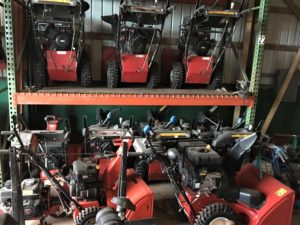By Jesse Lepinsky, Regional Fleet Manager
 It’s that time of year again when we are gearing up for snow removal. In past issues of the Greensheet, we have covered many related topics ranging from storm preparation and vehicle and equipment setup to safe plowing practices and equipment operating procedures. What goes on behind the scenes in the shop during the summer to prepare for snow removal could be somewhat of a mystery to some, however. Most of you are already familiar with our reconditioning program (recon, for short) and how it benefits production from an efficiency and image standpoint. What may not be obvious is the amount of time and effort that is invested in our snow removal equipment.
It’s that time of year again when we are gearing up for snow removal. In past issues of the Greensheet, we have covered many related topics ranging from storm preparation and vehicle and equipment setup to safe plowing practices and equipment operating procedures. What goes on behind the scenes in the shop during the summer to prepare for snow removal could be somewhat of a mystery to some, however. Most of you are already familiar with our reconditioning program (recon, for short) and how it benefits production from an efficiency and image standpoint. What may not be obvious is the amount of time and effort that is invested in our snow removal equipment.

In order to ensure we are operating at maximum efficiency in less than ideal weather conditions, our fleet team performs a thorough recon of all snow removal equipment during the summer months. Every plow, snow blower, salt spreader, power broom, and any other miscellaneous equipment is brought into the shop and inspected, serviced, repaired, and painted as needed. Each plow has the fluid replaced, cutting edges are inspected for wear beyond their serviceable limits, hoses and electrical wiring is repaired or replaced if needed, and all surfaces are treated to prevent corrosion while in storage.

Snow blowers and power brooms are serviced by changing the engine oil, fuel filters, and spark plugs. Augers and any other moving components are inspected for wear, bearings replaced, and the controls are verified to operate as designed. These same service procedures apply to any other powered snow removal equipment.
Tailgate and bulk spreaders can be some of the more involved pieces of snow equipment to recon. All units are function tested then brought back to peak performance. Although all units should be detail cleaned at the end of each season before being stored, some corrosion is inevitable. Any “frozen” components are freed up or replaced, all grease points are lubed, and all controls are verified to be in working order. They are then treated with rust preventative measures and returned to storage. Modifications are also performed to allow easier access to grease points and aid in maintenance between events. Due to the importance of these units during a storm, it is critical that the shops pay attention to every detail during the recon process.
Although we do everything possible to make sure our snow equipment is ready when the first flakes begin to fall, there are situations that are out of our control. We cover and protect our equipment to shield them from the elements, but this creates an attractive home for rodents and other pests who may decide to make a meal of the wiring. Likewise, stinging insects like to build nests inside the hoppers and may get upset when you need to relocate their home (ask me how I know). A good practice for all of our branches is to mount and test all snow equipment prior to any event being predicted during our annual “snow rodeo” training events. This will allow us to catch any problems that may have developed after the equipment was reconditioned and placed back in storage.
Once our trucks and equipment have finished working a storm, they come back to our facilities and are thoroughly cleaned and inspected before being put away—each branch must ensure that all trucks and snow equipment are pressure washed and all grease points are hit.
With the support of our field personnel in cleaning, maintaining, and properly operating our snow equipment, the fleet team is able to provide safe, efficient, and reliable equipment to get through one of the most demanding aspects of the job.